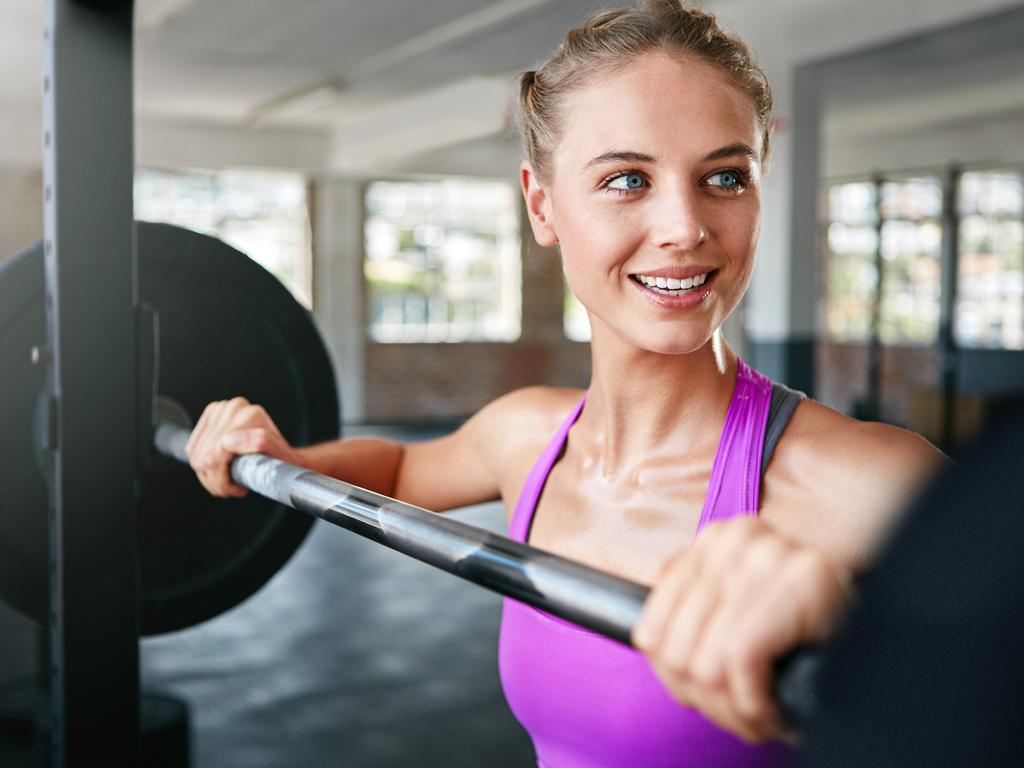I never thought I’d write this: I am a female bodybuilder
I stopped taking care of myself after two kids, my father’s death and the end of my marriage took a toll. Then, I discovered bodybuilding — and my outlook on life changed.

Two weeks ago, I stood on a stage in a hotel ballroom wearing a rhinestone bikini small enough to fit into a zip-lock bag.
I was competing in a women’s bodybuilding contest, and it was the culmination of months of hard work. I once would have been more likely to jump out of a plane than put myself on display in such skimpy attire. But here I was, flexing to thumping house music in clear 10cm heels as judges ranked my 45-year-old body.
To some friends and family, it seemed superficial. But beneath the layers of fake tan and blue eye shadow, the sport of bodybuilding had transformed me. It gave me confidence and reshaped how I view my physique, valuing strength over skinniness.
It’s a long way from where I was six years ago. In 2014, I had just given birth to my second daughter in December. My father died suddenly two weeks later. Six months after that, my marriage ended. Amid these tectonic shifts, I stopped taking care of myself. Though I had never been much of a drinker, wine started to feel pretty good. With food, I would eat the leftovers off my toddler’s plate and joke that I was a human vacuum cleaner.
I was never overweight, but I would look in the mirror and see problems: If I could only get rid of this roll or that bump. Gone was the confident athlete of my youth and college years, when I competed as a figure skater and in a Division I rowing crew at university. Now, I would sometimes attempt a jog, then give up and walk. It seemed pointless, as did the invitations to join running groups, yoga classes or marathons.
It’s an experience familiar to many women after motherhood. From battling hormonal shifts, to juggling a new role, to sleep deprivation and changes in body image, becoming a mother “can be a very destabilising time,” says Helen L. Coons, clinical director of women’s behavioural health and wellness at the University of Colorado School of Medicine. “Women have to refuel and bring their own tanks up.”
Lifting my way out of a slump
One February morning two years ago, something changed. I was staying in a hotel and decided to check out the gym. In there was a woman lifting barbells and dumbbells and pulling bands. She approached her workout with a grit I had seldom seen in mum circles. This wasn’t Pilates.
I asked her what regime she was following. She said she did bodybuilding competitions. She talked about how she would get on stage and compete against other women in a bikini, how her meal planning was entirely measured by “macros” — macronutrients. The discipline the sport required was daunting, but also held a powerful appeal for me.
She gave me the name of her coach, Tina Peratino, a 47-year-old retired bodybuilder in Bowie, Maryland. I emailed her, explaining that I needed some guidance. Her co-coach, Brandi Adams, asked me to start keeping a log of what I ate, and we found that daily calories were all over the place: some days as high as 2600, and others as low as 880. I looked fine, weighing 56kg. At that point, I had begun jogging and taking classes at Orangetheory. But the weights I used in the exercise classes appealed to me more than the cardio machines.
I began performing nearly two-hour daily weight-based workouts with exercises I had long associated with football players. Squats, dead lifts, bench presses. I wielded a barbell and was able to throw on more weight each week. As the weeks went by, I loved seeing what was happening to my body.
Body image shift
All of this went against every truth I thought I knew: Don’t lift too much weight, don’t get too bulky. Avoid carbs. Do only cardio. I wasn’t aiming for weight loss, but to build muscle while eliminating fat. Eating more — not less — would help feed muscles, my coach said. At my highest point in the coming months, I would eat 2600 calories a day.
I was tapping into a broader societal shift in body image. While thinness has long been associated with wealth and status, increasingly women are interested in looking strong. “There’s more of an emphasis on what your body can do, how much you can lift, what kind of workout can be accomplished,” says Jennifer Carter, a sports psychologist in Columbus, Ohio. Key moments in recent years, from the #MeToo movement to the success of the women’s national soccer team, have helped fuel the shift.
The intensity of lifting weights actually fuels a process called neuroplasticity: a rewiring of the brain that can connect the activity to enjoyment — and wanting more of it, says Jason McCray, a Columbus, Ohio, psychologist. “There are tangible gains you get in tracking and seeing (weight) numbers increase over time. When your muscles are engorged with blood, you are getting a rush of endorphins,” he says.
Those signals create feelings of positive reinforcement in brain pathways. “Your brain says, ‘I like this, I definitely want more’.”
I rearranged my schedule to do extra work at night or early in the morning before the kids woke up. Often my mother, who lives a few doors down, would watch my girls.
The training helped me outside the gym, too. The drudgery — weighing my food, lifting barbells — made me feel tougher and more confident. I came back to my desk with a wave of new ideas and fresh creativity. My work got better. My children were proud of me. One day at preschool pickup, I heard my daughter tell a friend that her mummy looked like Wonder Woman. “No, seriously,” I heard her say.

Getting competitive
My coaches encouraged me to enter a competition. I wasn’t sure. I had seen pictures and thought the fake tans were cheesy. The poses were a little too sexy. What would I tell my mother? What would my colleagues at The Wall Street Journal think?
And then I decided: Who cares?
I realised I wanted to own my appearance, my hard-earned muscles, and celebrate them. That belonged to me. I felt good about being a part of a community that applauded and encouraged the work that went into it.
I signed up for a competition that would take place several months later in May. Bodybuilding had become a part of my identity, the answer to people’s questions about my arms or my shoulders. “What do you do?” they would say. “I’m a bodybuilder” was now my response — not just that I worked out.
Then in March, the pandemic sent my routine into a tailspin. On the 13th, as I was completing a third set of single-arm dumbbell rows, an announcement came on that the gym doors would close at 4pm. I went to the locker room and wondered when I would return. I emptied my locker just in case, left, then changed my mind and came back to put some things back in. I didn’t want it to end here. Later, I went on Craigslist and bought $US900 ($1254) worth of used gym equipment to work out at home.
Pandemic hurts performance
But staying the course proved challenging. My competition slated for May got cancelled. I broke my diet several times, on one occasion bingeing on lunchbox treats. Sometimes working out seemed pointless. I would begin a set of exercises and catch myself staring at the wall.
I found support in a Facebook group for women bodybuilders that I joined as part of my work with my coach. She put together YouTube videos of workouts that could be done with basic home equipment. These women became my friends and teammates, even though I had met few of them in person. On Fridays, we would post pictures of ourselves flexing with the hashtag #flexfriday and cheer each other on. “Look at them guns!” wrote one.
Being part of a group of supportive athletes cannot only be a powerful motivator, but it can foster even higher performance standards. “It makes it a high performance atmosphere where people don’t think you are weird for doing things for your sport,” says sports psychologist Sheryl Smith.
In June, my coach asked if I would be interested in doing a competition that had opened up in August. I quickly responded yes. I felt exhilarated but nervous. I pulled out my clear plastic heels once again, to practice posing regularly in front of a full-length mirror.
On August 6, I drove more than three hours to Kenilworth, New Jersey, to enter my first competition. I packed the girl-power workout mix my daughters loved — our quarantine soundtrack — with hits from Beyoncé and Rihanna.
Because of the pandemic, audience size was kept to less than 25 people, so my children watched the live stream from home with my mum and their dad. Contestants wore masks, even on stage, and I had one made to match my purple bikini.
As I walked on stage for my first contest, I shrugged off my nerves, enjoying being nothing other than contestant Number 41. I smiled through my mask. Number 41 had won. I felt total joy and abandon. I competed in four divisions and placed first in three, and second in my class for another.
The next day I allowed myself to relax. I enjoyed a couple slices of pizza. My fiancé, Rick, and I went on a hike and climbed a waterfall. The steep climb to the top felt like a reflection of what I had accomplished the day before.
But I won’t rest long: I’m already training for my next competition on September 12.
The Wall Street Journal







To join the conversation, please log in. Don't have an account? Register
Join the conversation, you are commenting as Logout